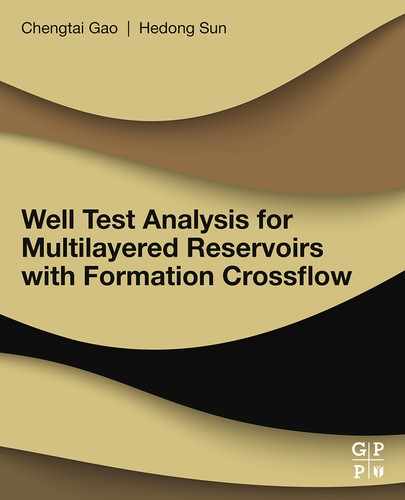Index
Note: Page numbers followed by f indicate figures, and t indicate tables.
A
arbitrary functions 294
asymptotic steady value 294
dependent variables 292
dimensionless crossflow velocity 71
exponential integral function 293
flow conditions 291
homogeneous equations 295
long time period 69–71
middle time period 69
numerical calculations 72
short time period 69–70
steady peak value 294
B
Buildup pressure 143–144
C
performace 259
constant pressure outer boundary condition 59–61
dimensionless wellbore pressure 60
governing equation 59
infinite outer boundary condition 59
wellbore boundary conditions 59–60
Computer program 272
Delphi programming language 272
downhole flow rate 272
multilayer interpretation theory 272
buildup case 208–209
nonlinear parameter estimation 209–210
D
Delphi programming language 272
arbitrary functions 294
asymptotic steady value 294
dependent variables 292
dimensionless crossflow velocity 71
exponential integral function 293
flow conditions 291
homogeneous equations 295
long time period 69–71
middle time period 69
numerical calculations 72
short time period 69–70
steady peak value 294
dimensionless expressions 66–68
five-layer cases 83–86
three-layer cases 75–82
dimensionless crossflow velocity 94
dimensionless expressions 93
approximate condition 94–95
boundary condition 94–95
new drawdown test 106–107
F
simulation parameters 253–254
area crossflow rates 86
approximate condition 94–95
boundary condition 94–95
crossflow, different boundary pressures 297–298
gas reservoir 10
characteristic dimension 6
Darcy’s law 6
law of mass conservation 7
local mass crossflow velocity 4
semipermeability 5–6
for steady and incompressible flow 7–8
unsteady flow 8
G
differential equations, linearization 11–12
fundamental differential equations 10
assumptions 9
local crossflow velocity 9
H
Horner plot 143–144
I
buildup curves 154
drawdown curve 151–154
Interpretation theory See also Unsteady crossflow (USC) model
buildup case 208–209
nonlinear parameter estimation 209–210
micro-annulus 194
dimension and dimensionless Laplace transformation 197–198
governing equations 315
known leakage rate 319
parameter estimation 199
reservoir parameters 199
steady-state crossflow 193
vertical interference testing 192
L
Leaky aquifer model See Pseudosteady crossflow (PSC) model
M
performance 259
deliverability equation and recharge equation 265
mathematical model 264–265
numerical simulation method 263
semipermeable wall model 262–263
with crossflow, mathematical model 251
factor analysis, reserve estimation 253–256
production performances, multilayer reservoirs 249
single-layer production, low permeability 258
without crossflow, mathematical model 250–251
buildup curves 154
drawdown curve 151–154
Darcy’s law 135
dimensionless parameters 135
formation properties, well test theory 134–135
one drawdown test 134
test and closed layers 135
drawdown tests 173–174
two-layer case, buildup period 176–177
two-layer case, drawdown period 174–176
pressure-test analysis 160
constant total rate 185–186
dimensionless parameters 186
steady layer rates 185–186
vertical permeability 189
wellbore storage 185–186
area crossflow rate 149
boundary crossflow 149
diffusivity crossflow 149
dimensionless crossflow velocity 149
dimensionless parameters 146–148
finite difference method 145
Horner plots 149
long time period 146–148
short time period 146–148
transition period 146–148
buildup case 143–144
early transition period 137–139
long time period 139–142
semipermeability determination 142–143
short time period 136
assumptions and three flow periods 161–163
buildup case 167–168
N
analytical solution 112
area crossflow rate 116
boundary conditions 111
by different boundary pressures 116–117
by different diffusivities 115–116
diffusivity crossflows See (Diffusivity crossflows)
initial conditions 111–112
interpretation method 155–157
parameters of individual layers, transient tests 180–182
unsteady flow 144–145
O
characteristic dimension 6
Darcy’s law 6
law of mass conservation 7
local mass crossflow velocity 4
semipermeability 5–6
for steady and incompressible flow 7–8
unsteady flow 8
assumptions 4
VE concept 4
vertical resistance 4
P
analytical solution 56–58
assumptions 38–39
crossflow causes 39
dimensionless crossflow velocity 39
dimensionless form equations 39
dimensionless wellbore pressure 47
skin factors 52
Pseudosteady crossflow (PSC) model 223–224
R
Reservoir parameter estimation 229–230
S
crosspoint of two straight lines 142–143
constant total rate 185–186
dimensionless parameters 186
steady layer rates 185–186
vertical permeability 189
wellbore storage 185–186
steady wellbore pressure differences 142
assumptions 9
local crossflow velocity 9
assumptions 4
VE concept 4
vertical resistance 4
Single-well chemical tracer test 66
diffusivity crossflows 69–70
dimensional synthetic diffusivity 163–164
dimensionless rate of layer 163
effective skin factor 163
two-layer reservoirs 309
unsteady flow 163–165
wellbore pressure 163
SW model See Semipermeable wall (SW) model
flow profile, stabilized rate 275
surface flow rate 275–276
T
constant pressure outer boundary condition 87
governing equation 86
infinite outer boundary condition 87
initial condition 86
no-flow outer boundary condition 87
pressure and rate derivation 87–89
wellbore boundary conditions 87
Transient well test methods 110
with crossflow, mathematical model 251
factor analysis, reserve estimation 253–256
production performances, multilayer reservoirs 249
single-layer production, low permeability 258
without crossflow, mathematical model 250–251
Two-layer reservoir See also Two-layer gas reservoir
real wellbore radii model 53–54
extension of 313–314
for long time period 309–311
for short time period 309
buildup case 312
constant pressure outer boundary condition 124
dimensionless governing equation 124
dimensionless pressure 125–127
infinite outer boundary condition 124
initial condition 124
no-flow outer boundary condition 124
skin factor inner boundary condition 127
wellbore boundary conditions 125
constant rate and pressure, boundary conditions 289
maximum effective hole-diameter 53–54
buildup period 176–177
drawdown period 174–176
partially perforated two-layer reservoir See (Partially perforated two-layer reservoir)
area crossflow rate 35–37
assumptions 28–29
governing equations 29
initial and boundary conditions 30
isolated homogeneous layer 27–28
mass crossflow rate 29
U
dimensionless parameters 225
steps 232–234
Laplace transform 226
boundary conditions 221
conservation of matter 222
flow problem 221
leakage rate, micro-annulus behind casing 223
PSC model 223–224
SW model 224–225
buildup case 143–144
early transition period 137–139
fundamental differential equations 8
long time period 139–142
semipermeability determination 142–143
approximate solution, long time period 166–167
approximate solution, short time period 163–165
assumptions and three flow periods 161–163
buildup case 167–168
short time period 136
USC model See Unsteady crossflow (USC) model
V
Vertical equilibrium (VE) concept 4
W
different layers 136
short time period 163
geological information 278–279
multilayer test 279–281
flow profile, stabilized rate 275
surface flow rate 275–276
..................Content has been hidden....................
You can't read the all page of ebook, please click here login for view all page.
